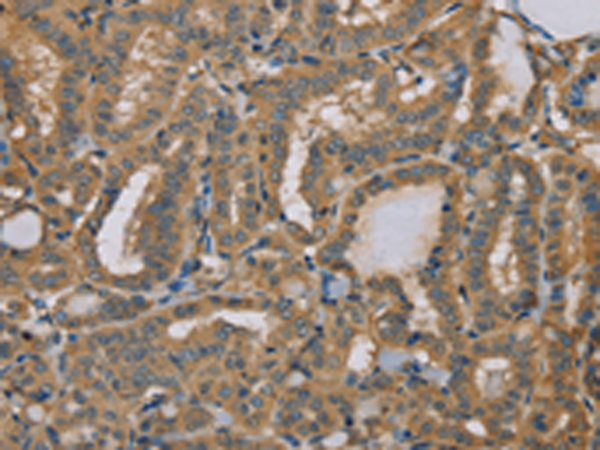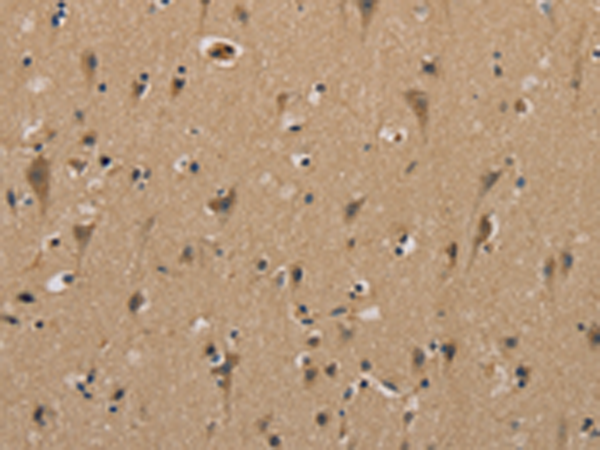


| WB | 咨询技术 | Human,Mouse,Rat |
| IF | 咨询技术 | Human,Mouse,Rat |
| IHC | 1/50-1/200 | Human,Mouse,Rat |
| ICC | 技术咨询 | Human,Mouse,Rat |
| FCM | 咨询技术 | Human,Mouse,Rat |
| Elisa | 1/2000-1/10000 | Human,Mouse,Rat |
| Aliases | CMH8; VLC1; MLC1V; MLC1SB |
| WB Predicted band size | 22 kDa |
| Host/Isotype | Rabbit IgG |
| Antibody Type | Primary antibody |
| Storage | Store at 4°C short term. Aliquot and store at -20°C long term. Avoid freeze/thaw cycles. |
| Species Reactivity | Human, Mouse, Rat |
| Immunogen | Fusion protein of human MYL3 |
| Formulation | Purified antibody in PBS with 0.05% sodium azide and 50% glycerol. |
+ +
以下是关于MYL3抗体的3篇参考文献及其摘要内容的简要概括(基于公开文献的模拟示例,供参考):
---
1. **文献名称**:*MYL3 mutations and their phenotypic expression in familial hypertrophic cardiomyopathy*
**作者**:Richard P, et al.
**摘要**:本研究通过基因测序发现MYL3基因突变与家族性肥厚型心肌病(HCM)相关,并利用MYL3抗体进行免疫组化分析,证实突变导致心肌细胞中肌球蛋白轻链3的异常聚集,提示其在心肌收缩功能失调中的作用。
---
2. **文献名称**:*Altered expression of MYL3 in a mouse model of cardiac hypertrophy*
**作者**:Chen J, et al.
**摘要**:通过构建压力超负荷诱导的小鼠心脏肥厚模型,研究显示MYL3蛋白表达水平显著下降。Western Blot和免疫荧光实验(使用MYL3抗体)进一步揭示了其表达变化与心肌细胞代偿性肥大的关联。
---
3. **文献名称**:*Immunohistochemical localization of MYL3 in human skeletal and cardiac muscle*
**作者**:Sugimoto T, et al.
**摘要**:利用特异性MYL3抗体,研究系统分析了MYL3蛋白在人类骨骼肌和心肌中的分布模式,发现其在慢缩肌纤维中高表达,为理解MYL3在肌肉疾病中的病理机制提供了形态学依据。
---
如需获取真实文献,建议通过PubMed或Google Scholar以“MYL3 antibody”、“MYL3 cardiomyopathy”等关键词检索,并筛选涉及抗体应用的实验研究。
The MYL3 antibody targets myosin light chain 3 (MYL3), a protein encoded by the MYL3 gene, which is part of the regulatory light chain family involved in muscle contraction. MYL3. also known as ventricular myosin essential light chain, is predominantly expressed in cardiac and slow skeletal muscle tissues. It binds to the myosin heavy chain, forming part of the myosin complex critical for ATPase activity and force generation during muscle contraction. MYL3 plays a key role in stabilizing the myosin lever arm, influencing contractile efficiency and calcium sensitivity.
Research using MYL3 antibodies focuses on understanding cardiac pathophysiology, particularly hypertrophic cardiomyopathy (HCM) and dilated cardiomyopathy (DCM), as MYL3 mutations are linked to these disorders. These antibodies are employed in techniques like Western blotting, immunohistochemistry, and immunofluorescence to detect MYL3 expression levels, localization, and interactions in tissue samples or cell models. Studies also utilize MYL3 antibodies to explore structural and functional changes in MYL3-deficient or mutated models, providing insights into disease mechanisms. Additionally, they aid in differentiating MYL3 isoforms from other myosin light chains (e.g., MYL2) in experimental analyses. Their application contributes to advancing diagnostics and therapeutic strategies for muscle-related diseases.
×